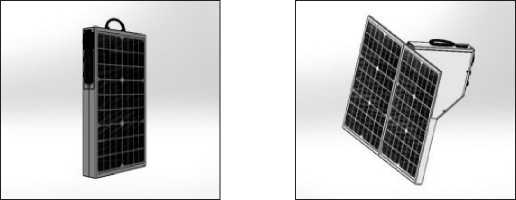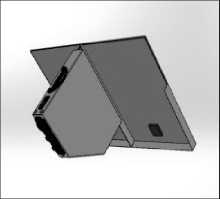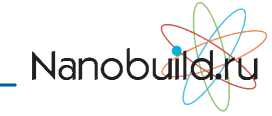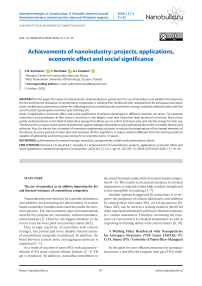Achievements of nanoindustry: projects, applications, economic effect and social significance
Автор: Smirnova L.N, Rucińska T., Zvezdov A.I.
Журнал: Nanotechnologies in Construction: A Scientific Internet-Journal @nanobuild-en
Рубрика: A review of the achievements of nanotechnology
Статья в выпуске: 1 Vol.12, 2020 года.
Бесплатный доступ
In the paper the review of achievements of nanoindustry is carried out: the use of nanosilica as an additive that improves the fire and thermal resistance of cementitious composites; a welding filler reinforced with nanoparticles for aerospace structures; smart, mobile and autonomous station for collecting and accumulating solar and electric energy; materials authentication with the use of nuclear quadrupole resonance spectroscopy, etc. Areas of application, economic effect and social significance of projects developed in different countries are given. For example, researchers and developers at Ben-Gurion University in the Negev, Israel and Ulyanovsk state technical University, Russia have jointly created a device in the field of alternative energy that allows you to collect and store solar and electric energy for later use. The device has a unique smart system of protection against voltage interruptions and overheating due to the controller devices and software. Also, the device has a number of innovative engineering solutions to reduce the temperature of the heated elements of the device, increase protection from dust and moisture. All this together is a unique solution different from the existing solutions capable of generating and storing solar energy for a long time (up to 10 years).
Achievements of nanotechnology, nanosilica, nanoparticles, mobile and autonomous station
Короткий адрес: https://sciup.org/142227435
IDR: 142227435 | DOI: 10.15828/2075-8545-2020-12-1-41-45
Текст научной статьи Achievements of nanoindustry: projects, applications, economic effect and social significance
MAIN PART
The use of nanosilica as an additive improving the fire and thermal resistance of cementitious composites
Nanomaterials were found to be a suitable admixtures and additives for decreasing the deterioration of cement based composites (mortars and concretes) under the thermal exposure. The most common types of nanomaterials used for this purpose are: nanosilica, carbon nanotubes, and nanoclays [1]. However, the biggest attention in the recent years has been paid to nanosilica (nano-SiO2).
Due to high reactivity of nanosilica with cement stronger, less porous and more durable microstructure of cementitious composite is produced. In addition, the bond between cement paste and aggregate particles is improved [2–3].
As a result of reaction of nano-SiO2 with calcium hydroxide (CH) more calcium silicate hydrate (C–S–H) gel is produced. In addition, nanosilica contributes to decreased thermal conductivity of cement-based composites [4–5]. This results in increased resistance to elevated temperature as material retains high residual strength and is less susceptible to cracking [5–7].
Another approach suggested by researchers is to improve the properties of cement admixtures and additives by coating them with nano-SiO2 via sol-gel process [8]. Nano-SiO2 can be used as a coating material (shell) for other nanosized admixtures with lower thermal resistance (i.e. carbon nanotubes). Therefore, increasing the resistance of core material to elevated temperature as well as improving its binding ability with cement matrix [9, 10].
A Welding Filler Reinforced with Nanoparticles for Aerospace Structures (NSF Grant 1345156/ PI: O.M. Suarez (PI) / University of Puerto Rico-Mayaguez)
In the quest for cost-efficient processes for aerospace structures, a new filler for tungsten inert gas (TIG) weld-
A REVIEW OF THE ACHIEVEMENTS OF NANOTECHNOLOGY ing of aluminum structures was developed using nanoparticles as reinforcements.
This aluminum-based nanocomposite becomes an appealing alternative to commercial aluminium alloy fillers with lower thermal expansion coefficient and adjustable electrical resistivity to attain reasonable welding temperatures.
This breakthrough technology is based on years of development at the University of Puerto Rico of new aluminum matrix composites reinforced with diboride particles [11–12].
Further development led to a US patent [13].
This permitted a better understanding of the processing techniques needed to fabricate wires reinforced with nanoparticles with adjustable electrical resistivity and melting temperatures without significantly modifying the chemical composition [14–15].
Nowadays, the developers of these novel fillers are working on optimization parameters that concern: a) proper adjustment of the nanoparticle size and distribution in the wire; b) stir melting of the wires’ parent composite; c) wire annealing and cold working; d) alternative alloying with minor additions of metals forming solid solutions with aluminum.
One important operation benefit is that no new TIG welding methods need to be developed, as the fillers are designed to be interchangeable with competing commercial ones.
Thus, this welding material can raise the standards of quality tools and infrastructure.
After practical approval the novel filler not only would meet tight aerospace specifications but also expands the range of possibilities of new derivative technologies.
In summary, the new material assists in providing improved operational efficiency in aerospace structure technology.
Smart, mobile and Autonomous station for collecting and accumulating solar and electric energy
Researchers and developers at Ben-Gurion University in the Negev, Israel and Ulyanovsk state technical University, Russia have jointly created a device in the field of alternative energy that allows you to collect and store solar and electric energy for later use [16].
This device is an intelligent, mobile and Autonomous station for collecting and accumulating solar and electric energy, for use in smart production, smart transport and smart home. The device is capable of providing an output voltage of 100–240 V, USB charging with support for many standards of fast charging, as well as an output voltage of 12–16 V to the cigarette lighter socket. There are options for voltage output to various standards of sockets, including universal. The device has a unique, smart engineering T-shaped design that can be transformed into a mobile case for transportation and storage of the device.
The device in the unfolded form has a folding surface of solar panels on the type of accordion, the number of panels can be arbitrarily much to improve performance, in the lower, Central part, under the surfaces of solar panels is the main body containing all the main components of the device: batteries of the required capacity, AC inverter, microcontroller control software, protection controller, holders, wires, diodes, buttons, switches, output sockets, input connectors, control display, heat dissipation plates, sensors of orientation, illumination, temperature and other devices are possible for different versions of the main device, to achieve maximum output parameters. The device (Fig. 1) has a unique smart system of protection against voltage interruptions and overheating due to the controller devices and software, and the device has a number of innovative engineering solutions to reduce the temperature of the heated elements of the device, increase protection from dust and moisture. All this together is a unique solution different from the existing solutions capable of generating and storing solar energy for a long time up to 10 years.
Solar panels in the open sun at high ambient temperatures have the properties to heat up to very high temperatures, which is a problem of portable devices containing solar panels, battery systems, inverters and other electronics necessary for the operation of the device, which also emit heat during operation. It is necessary to isolate the contact of the housing and solar panels, to exclude its heating from direct sunlight and to ensure the removal

Fig. 1. General view of the device

A REVIEW OF THE ACHIEVEMENTS OF NANOTECHNOLOGY and dispersion of heat from all components of the system and their continuous temperature control. For these purposes, the main body of the device is located in the shade of solar panels, as well as in the body of the device there is a U-shaped air channel for air circulation, which reduces the average temperature by 5–10 degrees, as well as to the walls of the body installed heat dissipation panels that remove internal heat to the ventilated outer walls of the body, which reduces the average temperature by 10–15 degrees, thus reducing the risk of overheating of the system of devices and batteries.
The microcontroller regulates the operation of the devices and provides a stable and efficient operation of the system and protection against overheating. Thus, the set of systems and factors in the complex are interrelated and allow to achieve the most effective result.
Materials authentication using nuclear quadrupole resonance spectroscopy (NSF Grant 1563688/ Soumyajit-Mandal, Hope Barkoukis, SwarupBhunia / Case Western Reserve University, University of Florida)
Counterfeit, substandard, and/or contaminated pharmaceuticals, dietary supplements, and food items have emerged as a major worldwide health problem.
High-value items such as packaged medicines, which are often sold online through untrusted supply chains, are particularly prone to fraud.
The trade in such illicit medicines is worth tens of billions of dollars annually, and these products now account for about 20% of all illegal goods seized at national borders.
This project is developing spectroscopy, data analysis, and machine learning techniques that exploit the nanoscale structure of materials in the solid state for authenticating their chemical composition.
The overall goal is to enable users throughout the supply chain to reliably verify the identity and source of consumables (medicines, supplements, and food items) using portable and low-cost devices.
The adoption of such authentication technology is expected to eventually have a major positive impact on public health by enhancing the security of the supply chain for consumables.
About 50% of all the atoms in the periodic table contain so-called quadrupolar nuclei that generate nuclear quadrupole resonance (NQR) spectra [17–18].
These include common nuclei such as nitrogen (14N) and chlorine (35Cl and 37Cl).
The proposed authentication approach takes advantage of the sensitivity of such NQR spectra to the electric field gradient (EFG) tensor in the neighborhood of the quadrupolar nucleus, which in turn is primarily determined by the spatial distribution of valence electrons in the crystal lattice.
Thus, such spectra are highly sensitive to chemical composition and physical properties, i.e., act as unique «chemical signatures» that are difficult to emulate or falsify.
Our work has focused on i) understanding the fundamental physical principles that underlie the generation of such signatures; and ii) optimizing the sensors, measurement protocols, data analysis methods, and classification techniques to improve sensitivity and specificity, and thus the precision with which such signatures can be measured.
CONCLUSION
The Editorial Board of the electronic edition «Nano-technologies in Construction: A Scientific Internet-Jour-nal» invites authors and organizations to publish materials in the heading «A review of the achievements of nano-technology». Articles (metadata of articles) take places in «open access»:
– on the website of the electronic edition «Nanotech-nologies in construction: a scientific internet-journal» , next-section «Archive of numbers»;
– in the full text database of open access scientific journals Open Academic Journals Index (OAJI), ;
– on the website of scientific electronic library, ;
– in the base of scientific journals Directory of Open Access Journals (DOAJ),, then – search journal «Nanotehnologii v Stroitelʹstve»;
– in the base of scientific journals ResearchBib, ;
– on the Internet resource of scientists of all scientific disciplines ResearchGate, https://www.researchgate. net/journal/2075-8545_Nanotechnologies_in_Con-struction;
– in the international scientific base Readera – other.
This allows scientists and specialists around the world to get acquainted with the materials of the journal for free and use them in their activities, including quoting in their articles.

A REVIEW OF THE ACHIEVEMENTS OF NANOTECHNOLOGY
Список литературы Achievements of nanoindustry: projects, applications, economic effect and social significance
- Sikora P., Abd Elrahman M, Stephan D. The influence of nanomaterials on the thermal resistance of cement-based composites – a review. Nanomaterials. 2018, Vol. 8, no. 7, pp. 465. DOI: 10.3390/nano8070465.
- Skoczylas K., Rucińska T. Strength and durability of cement mortars containing nanosilica and waste glass fine aggregate. Cement Wapno Beton. 2018, Vol. 3, pp. 206–215.
- Skoczylas K., Rucińska T. The effects of waste glass cullets and nanosilica on the long-term properties of cement mortars. E3S Web of Conferences. 2018, Vol. 49, pp. 00102. DOI: 10.1051/e3sconf/20184900102.
- Sikora P., Horszczaruk E., Skoczylas K., Rucinska T. Thermal properties of cement mortars containing waste glass aggregate and nanosilica. Procedia Engineering. 2017, Vol. 196, pp. 159–166. DOI: 10.1016/j.proeng.2017.07.186.
- Kumar R., Singh S., Singh L.P. Studies on enhanced thermally stable high strength concrete incorporating silica nanoparticles. Construction and Building Materials. 2017, Vol. 153, pp. 506–513. DOI: 10.1016/j.conbuildmat.2017.07.057.
- Yan L., Xing Y., Zhang, J., Li J. High-temperature mechanical properties and microscopic analysis of nano-silica steel fibre RC. Magazine of Concrete Research. 2013, Vol. 65, pp. 1472–1479. DOI: 10.1680/macr.13.00143.
- El-Gamal S.M.A.; Abo-El-Enein S.A., El-Hosiny F.I., Amin M.S., Ramadan, M. Thermal resistance, microstructure and mechanical properties of type I Portland cement pastes containing low-cost nanoparticles. Journal of Thermal Analysis and Calorimetry. 2018, Vol. 131, no. 2, pp. 949–968. DOI: 10.1007/s10973-017-6629-1.
- B. Coppola B, Di Maio L., Scarfato P., Incarnato L. Use of polypropylene fibers coated with nano-silica particles into a cementitious mortar. AIP Conference Proceedings. 2015, Vol. 1695, pp. 020056. DOI: 10.1063/1.4937334.
- Sikora P., Abd Elrahman M., Chung S.-Y., Cendrowski K., Mijowska E., Stephan D. Mechanical and microstructural properties of cement pastes containing carbon nanotubes and carbon nanotube-silica core-shell structures, exposed to elevated temperature. 2019, Vol. 95, pp. 193–204. DOI: 10.1016/j.cemconcomp.2018.11.006.
- Katarzyna S., Rucińska T. The effects of low curing temperature on the properties of cement mortars containing nanosilica. Nanotechnologies in Construction. 2019, Vol. 11, no. 5, pp. 536–544. DOI: 10.15828/2075- 8545-2019-11-5-536-544.
- Suarez, O.M., Vazquez, J., & Reyes-Russi, L. (2009). Synthesis and Characterization of Mechanically Alloyed Al/AlxMg1-xB2 Composites. Science and Engineering of Composite Materials, 16(4), pp. 267–276. https://doi.org/10.1515/SECM.2009.16.4.267.
- Corchado, M., Reyes, F., & Suarez, O.M. (2014) Effects of AlB2 Particles and Zinc on the Absorbed Impact Energy of Gravity Cast Aluminum Matrix Composites. JOM, 66(6), pp. 926–934. https://doi.org/10.1007/s11837-014-0911-5.
- US Patent 8,820,390 B2: “Methods and Compositions for Boride Distribution in Metal Matrix Composite”, Inventors: A.Cintron-Aponte, J.R. Vazquez Gomez, O.V. Suarez, S.R. Pedraza-Torres. Sept. 2014.
- Florian-Algarin D., Ramos-Morales A., Marrero-Garcia M. & Suarez O.M. (2018). Study of Aluminum Wires Treated with MoB2 Nanoparticles. Journal of Composites Science, 2(3).
- Florian-Algarin D., Marrero R., Li X., Choi H. & Suarez O.M. (2018). Strengthening of Aluminum Wires Treated with A2O6 / Alumina Nanocomposites. Materials, 11 (3).
- Malkin P., Shurupov A. N., Zaitsev M. A., Eschenko K. E. Smart, mobile and Autonomous station for collection and accumulation of solar and electric energy, patent application 495035465, – 2019.
- Chen C., Zhang F., Barras J., Althoefer K., Bhunia S., Mandal S. Authentication of medicines using nuclear quadrupole resonance spectroscopy, Trans. Computational Biology&Bioinformatics, Vol. 13:3, pp. 417–430, 2016.
- Chen C., Zhang F., Bhunia S., Mandal S. Broadband Quantitative NQR for Authentication of vitamins and Dietary Supplements, Journal of Magnetic Resonance, Vol. 278, pp. 67–79, 2017.


